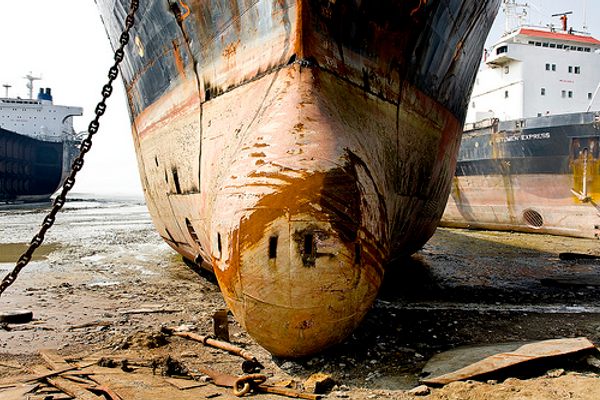Scavenger Cities
Landfill operations in Jamaica Bay, New York (1973) (photograph by Arthur Tress)
Before the rise of modern waste management systems, the trash produced by the intense urbanization of the 17th century was dealt with through mainly informal channels — the rag-collectors and charnel-men, the night-soil men and toshers, mudlarks and flushermen, who all sifted through the detritus of society, earning a pittance in exchange for the recyclables they collected, some of which we would not recognize as being recyclable at all.
Urine was collected via “piss-pots,” placed strategically outside taverns, and was then sold on to tanneries. Vegetable scraps were collected to sell either to those poorer than the collectors, or to urban farmers as food for pigs and cattle. As populations continued to rise and migration to urban centers exploded, the cities themselves became health hazards, and it took the pioneering efforts of people like Eugène Belgrand who designed Paris’s sewerage system between 1852 and 1869, Joseph Bazalgette in London, and George E. Waring, Jr., who used his Civil War experience to militarize the Sanitation Department in New York City after the fall of corrupt Tammany Hall, and cleared the streets of often-shin-high waste.
Scavenging in Jakarta (2004) (photograph by Jonathan McIntosh)
Other than the men and women pushing shopping trolleys filled with rusting cans, and the nocturnal missions of dumpster diving, either for food, or, as in Cory Doctorow’s novel Someone Comes to Town, Someone Leaves Town, for electrical components, the subsistence-level rubbish collector seems to belong in the past.
In Southeast Asia, India, South America, and Africa, however, the traditional task of the unofficial garbage collectors goes on, and is still dirty, unhygienic, and dangerous.
Payatas Dumpsite in the Philippines (2007) (photograph by Kounosu/Wikimedia)
Collecting trash in Calcutta, India (photograph by butforthesky/Flickr user)
The wages are pitiful, as unscrupulous residents often avoid even the merest donations. In India, where the garbage collectors are often a part of the dalit — or the “untouchables,” the lowest class in the Indian caste system — the waste collectors live on the fringes of society, and are treated patronizingly by the national government.
When, for example, the garbage collectors recently asked for a wage, rather than being forced to rely on the current donation system, the government responded by issuing gloves as an inducement to better hygiene practices, rather than the money these people so desperately need. In Egypt, where waste management has been, since at least the 1940s, the preserve of the zabaleen, a group mostly composed of the country’s minority Coptic Christians, the government has removed from them even this pittance of a livelihood, through introducing and legislating in favor of modern waste management systems, and by contracting this role to multinational companies operating outside of Egypt.
A Donkey at Moqattam Hill in Cairo (2007) (photograph by Matthias Feilhauer)
Mokattam, Egypt (photograph by Ayoung Shin)
In the favelas of Brazil, even the cartoneros live highly stratified lives. The young and the good looking find work in nicer, more affluent (and presumably less effluent) neighborhoods, where tips and donations are higher. They regularly face police crackdowns, as a result of accusations of theft, as well as the violence of the drug traders who operate in the slums. In Southeast Asia, women sift and trawl their way along the polluted waterways, searching primarily for paper. In the Philippines, children pick their way atop burning rubbish piles.
Even in a developed nation like Japan, the Burakumin (literally “hamlet/village people”) continue to be shunned and ostracized, forced to live on the outskirts of cities and towns, and severely limited in terms of what jobs they can perform, despite decades of government-level attempts to legislate against this discrimination. In Bangladesh, men, women, and children salvage wrecked ships, abandoned on their beaches by profiteering multinational corporations, despite the toxic chemicals and heavy metals that contaminate the hulks, and in spite of the risk to life that this engenders. The challenge stands, to raise the quality of life for these people.
Ship breaking in Bangladesh (photograph by Stéphane M. Grueso)
Ship breaking in Bangladesh (photograph by Naquib Hossain)
Charities have sprung up in the Western world to provide some source of training or appropriate recompense for trash pickers, such as Practical Action, which works to help waste pickers in Nepal, and the Saga Charitable Trust , which supports the poor in the Philippines. Two questions will remain, however, if trash picking is replaced in the developing world by modern sanitation systems.
Firstly, how will struggling economies cope with the demand for waste management systems of a Western standard? And secondly, what will become of the people who are engaged in this much maligned role? Will they go the way of Egypt’s Coptic Christians, and fall further into poverty and desperation? We must find some way of retraining and reintegrating these people into societies where they are traditionally derided as outsiders, as less-than-human.
Throughout the Western world in the past, and in much of the rest of the world today, the life and work of the garbage collectors is, in the co-opted words of Thomas Hobbes, nasty, brutish, and short.










Follow us on Twitter to get the latest on the world's hidden wonders.
Like us on Facebook to get the latest on the world's hidden wonders.
Follow us on Twitter Like us on Facebook